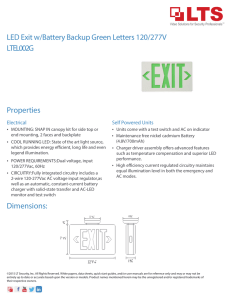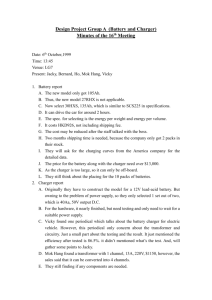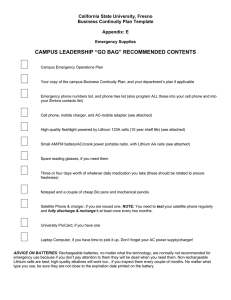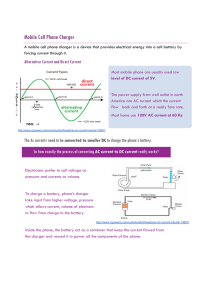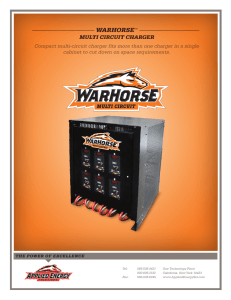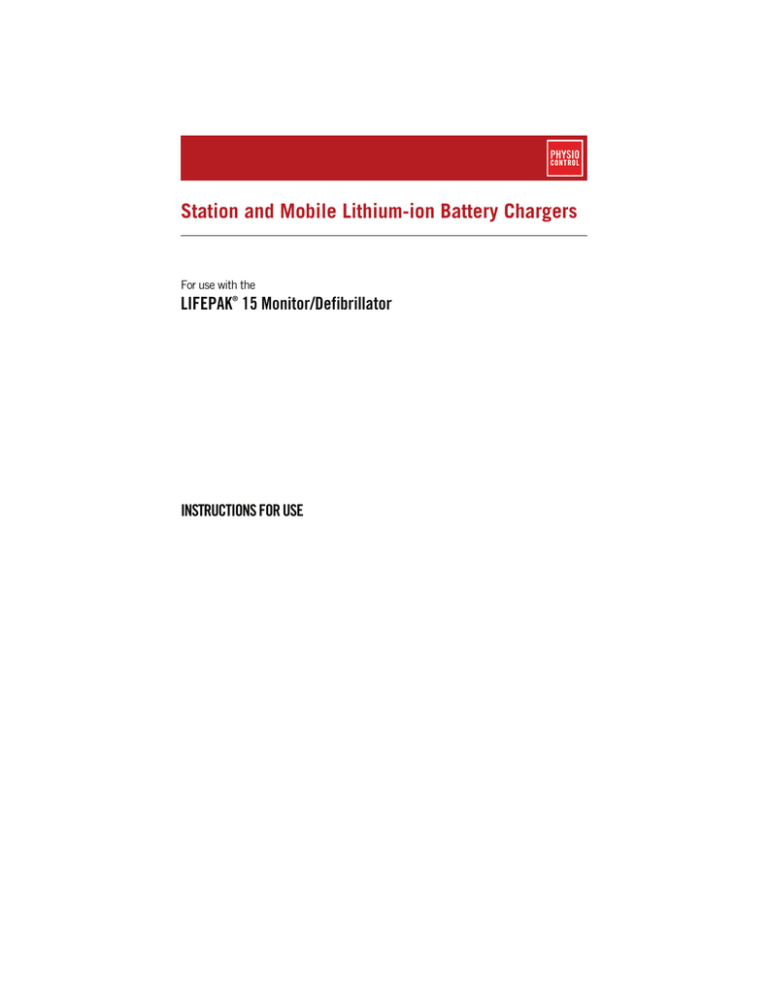
Station and Mobile Lithium-ion Battery Chargers
For use with the
LIFEPAK 15 Monitor/Defibrillator
®
INSTRUCTIONS FOR USE
CONTENTS
English . . . . . . . . . . . . . . . . . . . . . . . . . . . . . . . . . . 1
ENGLISH
Station and Mobile Lithium-ion Battery Chargers
The LIFEPAK® 15 Monitor/Defibrillator Station Lithium-ion (Li-ion) Battery Charger and
Mobile Li-ion Battery Charger are intended for use only with LIFEPAK 15
Li-ion rechargeable batteries.
IMPORTANT! No other batteries are compatible with these chargers. To avoid
confusion between batteries for the LIFEPAK 15 and the LIFEPAK 12 defibrillator/
monitors, segregate charger and battery storage locations for each device. Batteries,
chargers, and monitors are designed by fit and color to help prevent incorrect pairing.
•
•
The Station Charger is designed for use indoors in a controlled environment. The
Station Charger uses AC power only.
The Mobile Charger can be used indoors as well as in a mobile-type environment.
The Mobile Charger uses AC or DC power.
DANGER
EXPLOSION HAZARD Do not use this device in the presence of flammable gases or
anesthetics.
WARNING
POSSIBLE EXPLOSION, FIRE, OR NOXIOUS GAS The battery charger is for use with
LIFEPAK 15 monitor/defibrillator Li-ion rechargeable batteries only. Attempting to
charge a battery that is not designed for this charger can cause an explosion, fire, or
release of noxious gas.
POSSIBLE LOSS OF POWER DURING PATIENT CARE Physio-Control has no information
regarding the performance or effectiveness of this Li-ion battery charger for use with
other manufacturers’ batteries. Using other manufacturers’ batteries may result in
battery charger failure. Use only Physio-Control batteries and the appropriate
Physio-Control battery charger.
POSSIBLE ELECTRICAL INTERFERENCE Equipment operating in close proximity may
emit strong electromagnetic or radio frequency interference (RFI), which could
affect the performance of this device. RFI may result in inadequate battery
charging. Avoid operating the device near RF communications equipment. Refer to
Table 3 on page 8 for recommended distances of equipment. Contact PhysioControl technical support if assistance is required.
The LIFEPAK 15 Li-ion battery chargers are intended for use by trained operators only.
Contents
The charger package includes:
• One battery charger (Station or Mobile)
• One AC power cord (country/region specific)
• One DC power cable (Mobile Charger only)
• One mounting bracket with 4 (8-32 x 0.5”) screws, 4 lock washers, and template
1
Mounting the Charger
You can use the Station or Mobile Charger on a solid horizontal surface, or mount the
charger on a horizontal or vertical surface using the mounting bracket provided.
The following procedures refer to Figures 1 and 2 in the Mounting Bracket Template
(Template) that ships with the bracket.
IMPORTANT! Make sure the mounting surface can support the charger.
1. Attach the mounting bracket to the charger:
A. Align the bracket with the bottom of the charger as shown in Figure 1 in the
Template.
B. Attach the bracket to the charger using the four screws and lock washers
(provided) and tighten using a #2 Phillips screwdriver.
C. If using AC power, connect the AC power cord to the battery charger now. Do
NOT plug the AC power cord into the wall outlet at this time.
2. Mount the charger to the surface:
Note: You need four #8 or M4 bolts (not included) or other hardware appropriate for
your mounting surface.
A. Use the Template to mark the four locations for the mounting bolts on the
surface.
B. Drill appropriate-sized holes for the mounting hardware you are using.
C. Use the mounting hardware to attach the bracket to the mounting surface as
shown in Figure 2 in the Template.
CAUTION
POSSIBLE EQUIPMENT DAMAGE
• The battery charger must be used indoors only.
• Use only the designated power cords, cables, and mounting bracket.
• Do not place the charger near sources of moisture or liquids.
• If using the mounting bracket, make sure the charger and mounting bracket
are securely attached to the mounting surface prior to use.
• Inadequate wall or surface construction, or improper installation of the
mounting bracket may result in bodily injury.
• Inspect the power cables for damage prior to use.
Setting Up the Charger
IMPORTANT! The AC power cord and the DC power cable are the safety disconnect
mechanisms. Maintain clear access to all connections and the wall outlet at all times.
To set up the battery charger for AC power only:
1. Connect the AC power cord to the battery charger AC port.
2. Plug the AC power cord into the wall outlet.
To set up the battery charger for AC/DC power (Mobile Charger only):
1. Connect the two wires from the DC power cable to the 12 VDC power source—red or
brown for positive, black for negative.
2. To insert the DC power cable, align the DC power connector notch with the
corresponding key in the DC port. Twist the plastic locking ring clockwise until it
locks.
2
3. If AC power will be used simultaneously with DC power, plug the AC power cord into
the wall outlet. When both AC and DC power are available, the charger
automatically selects AC power.
All LEDs flash briefly when power is first applied to the charger.
Charging Bays
Bay LEDs
(green)
Bay LEDs
(red)
Power LED
Figure 1 LIFEPAK 15 Li-ion Battery Charger
The single green power LED in the center of the charger label indicates the status of the
charger:
• On—Power is applied.
• Off—Power is not applied, or internal fault.
Charging the Batteries
Fully charge the batteries prior to use, and fully recharge batteries once per year if in
storage.
To charge a battery:
1. Inspect battery for damage or leakage. If battery is damaged or leaking, recycle the
battery and obtain a new battery.
2. Verify that the battery charger is powered on (the Power LED is illuminated).
3. Insert the battery into one of the bays on the charger. You can charge one or two
batteries simultaneously.
4. Observe the bay LEDs on the charger. Each bay has two LEDs. The LEDs are
described in the following table.
BAY LED
EXPLANATION
STATUS
A fully depleted battery typically takes up to 4.25 hours to
charge.
Flashing
Green
Battery is charging.
Solid
Green
If a battery remains in the charger after it is charged, the
Battery charging is
charger enters maintenance mode and periodically charges
complete.
the battery to keep it optimally charged.
Both Off
No battery
installed.
If bay LEDs are off when a battery is installed and power is
applied, an internal charger fault has occurred or the battery
is faulty. Contact your authorized service personnel.
3
BAY LED
EXPLANATION
STATUS
Solid red
Remove battery and check fuel gauge. If the charger’s solid
Battery or charger is
red LED persists when a functional battery is installed, the
faulty.
charger is faulty. Contact your authorized service personnel.
Flashing
red
The battery temperature is too hot or too cold for battery
Environment is too charging operation. Remove battery to room temperature;
allow sufficient time to adjust and then reattempt battery
hot or too cold.
charging.
Flashing
red and
green
Charger is faulty.
If either or both sets of bay LEDs repeatedly flash red and
green, the charger is faulty. Contact your authorized service
personnel.
The fuel gauge on the LIFEPAK 15 Li-ion battery has four LEDs that indicate the
approximate level of charge. Push the gray button beside the battery symbol to activate
the LEDs. Four visible LEDs indicate full charge.
For more information about the batteries, see the LIFEPAK 15 Monitor/Defibrillator
Operating Instructions.
Charger Maintenance and Recycling
The battery chargers are designed to be maintenance free.
• Keep away from moisture.
• Clean only with dry or slightly damp, lint-free cloth.
• Do not clean with a flammable cleaner.
• Do not block ventilation slots.
• Do not disassemble. The charger has no internal user-serviceable parts.
• Routinely inspect battery pins for wear or scraping. If damaged, contact your
authorized service personnel.
• Inspect the power cables for damage and replace, if needed.
Recycle the charger at the end of its useful life according to national and local
regulations. For instructions on disposing of this product, see http://
recycling.medtronic.com.
Symbols
The following symbols may be found on the battery charger or its accessories. A
complete list of symbols and their definitions can be found in the LIFEPAK 15 Monitor/
Defibrillator Operating Instructions.
SYMBOL
DESCRIPTION
Attention, consult accompanying documents
Battery charger
Do not dispose of this product in the unsorted municipal waste stream.
Dispose of this product according to local regulations. For instructions
on disposing of this product, see http://recycling.medtronic.com.
4
SYMBOL
DESCRIPTION
PN
or
MIN Manufacturer’s identification number (part number)
REF
or
CAT
SN
IP31
Catalog number
Serial number
Enclosure ingress protection code per IEC 60529
Mark of conformity according to the European Medical Device
Directive 93/42/EEC
Mark of conformity to Canadian and US standards
Output
Input
YYYY
Date of manufacture
DC voltage
AC voltage
Manufacturer
Authorized EC representative
Safety Class II equipment (double or reinforced insulation)
Product Specifications
SPECIFICATION
DESCRIPTION
Supported Battery
LIFEPAK 15 Lithium-ion 5.7 Ah Rechargeable Battery
Power Requirements
AC input: 100–240 VAC 50/60 Hz, 1.4 A maximum
DC input: 11.1–14.5 VDC, 8 A maximum (Mobile Charger only)
Operating Temperature
AC input: 10°–40°C (50°–104°F)
DC input: 5°–50°C (41°–122°F) (Mobile Charger only)
Storage Temperature
-40°–70°C (-40°–158°F)
Charge Time
Typical charge time for a fully depleted battery: 4 hours and 15
minutes
Safety Class
AC powered: Safety Class l (with Class 2 parts)
DC powered: Safety Class ll (reinforced insulation)
Altitude
795 mmHg to 522 mmHg
-382 to 3048 m (-1253 to 10,000 ft)
5
SPECIFICATION
DESCRIPTION
Object and Water
Resistance
IP31 per IEC 60529
Electromagnetic Emissions
Table 1 Guidance and Manufacturer’s Declaration - Electromagnetic Emissions
The LIFEPAK 15 Li-ion battery charger is intended for use in the electromagnetic environment
specified below. The customer or user of the battery charger should ensure that the device is used
in such an environment.
Emissions Test
Compliance
Electromagnetic Environment - Guidance
RF emissions
Group 1
The LIFEPAK 15 Li-ion battery charger uses RF energy
only for its internal function. Therefore, its RF emissions
are very low and are not likely to cause any interference
in nearby electronic equipment.
Class A
The LIFEPAK 15 Li-ion battery charger is suitable for
use in all establishments other than domestic and those
directly connected to the public low-voltage power
supply network that supplies buildings used for domestic
purposes.
CISPR 11
RF emissions
CISPR 11
Harmonic emissions
Class A
IEC 61000-3-2
Voltage fluctuations/ Complies
flicker emissions
IEC 61000-3-3
Essential Performance
The LIFEPAK 15 Li-ion battery charger maintains safe and effective performance of the
battery charging functions when operated in the electromagnetic environment specified
in Table 2 through Table 4.
Table 2 Guidance and Manufacturer’s Declaration - Electromagnetic Immunity
The LIFEPAK 15 Li-ion battery charger is intended for use in the electromagnetic environment
specified below. The customer or user of the battery charger should ensure that the device is used
in such an environment.
Immunity Test
Electrostatic
discharge (ESD)
IEC 60601
Test Level
Compliance Level
±6 kV contact
±6 kV contact
±8 kV air
±8 kV air
Electrical fast
transient/burst
±2 kV for power
supply lines
±2 kV for power
supply lines
IEC 61000-4-4
±1 kV for input/
output lines
Not applicable
Surge
±1 kV line(s) to
line(s)
±1 kV line(s) to
line(s)
±2 kV line(s) to
earth
±2 kV line(s) to
earth
IEC 61000-4-2
IEC 61000-4-5
6
Electromagnetic Environment Guidance
Floors should be wood, concrete, or
ceramic tile. If floors are covered
with synthetic material, the relative
humidity should be at least 30%.
Mains power quality should be that
of a typical commercial or hospital
environment.
Mains power quality should be that
of a typical commercial or hospital
environment.
Table 2 Guidance and Manufacturer’s Declaration - Electromagnetic Immunity (Continued)
The LIFEPAK 15 Li-ion battery charger is intended for use in the electromagnetic environment
specified below. The customer or user of the battery charger should ensure that the device is used
in such an environment.
Immunity Test
Voltage dips,
short
interruptions and
voltage variations
on power supply
input lines
IEC 60601
Test Level
Compliance Level
<5% UT
<5% UT
(>95% dip in UT) for (>95% dip in UT)
0.5 cycle
for 0.5 cycle
40% UT
(60% dip in UT)
for 5 cycles
40% UT
(60% dip in UT)
for 5 cycles
IEC 61000-4-11 70% U
T
(30% dip in UT)
for 25 cycles
70% UT
(30% dip in UT)
for 25 cycles
<5% UT
<5% UT
(>95% dip in UT) for (>95% dip in UT)
5 sec
for 5 sec
Power frequency
(50/60 Hz)
magnetic field
IEC 61000-4-8
3 A/m
3 A/m
Electromagnetic Environment Guidance
Mains power quality should be that
of a typical commercial or hospital
environment. If the user of the
LIFEPAK 15 Li-ion battery charger
requires continued operation during
power mains interruptions, it is
recommended that the LIFEPAK 15
Li-ion battery charger be powered
from an uninterruptible power
supply or battery.
Power frequency magnetic fields
should be at levels characteristic of
a typical location in a typical
commercial or hospital
environment.
Note: UT is the AC Mains voltage prior to application of the test level.
7
Table 3 Guidance and Manufacturer’s Declaration - Electromagnetic Immunity
The LIFEPAK 15 Li-ion battery charger is intended for use in the electromagnetic environment
specified below. The customer or user of the battery charger should ensure that the device is used
in such an environment.
Immunity Test
IEC 60601
Test Level
Compliance
Level
Electromagnetic Environment - Guidance
Portable and mobile RF communications
equipment should be used no closer to any
part of the LIFEPAK 15 Li-ion battery
charger, including cables, than the
recommended separation distance
calculated from the equation applicable to
the frequency of the transmitter.
Recommended separation distance
Conducted RF
3 Vrms
3 Vrms
d = 1.2
P
d = 1.2
P 80 MHz to 800 MHz
d = 2.3
P 800 MHz to 2.5 GHz
IEC 61000-4-6 150 kHz to
80 MHz
Radiated RF
3 V/m
IEC 61000-4-3 80 MHz to
2.5 GHz
3 V/m
Where P is the maximum output power
rating of the transmitter in watts (W)
according to the transmitter manufacturer
and d is the recommended separation
distance in meters (m).
Field strengths from fixed RF transmitters,
as determined by an electromagnetic site
survey,a should be less than the compliance
level in each frequency range.b
Interference may occur in the vicinity of
equipment marked with the following
symbol:
Note 1: At 80 MHz and 800 MHz, the higher frequency range applies.
Note 2: These guidelines may not apply in all situations. Electromagnetic propagation is affected
by absorption and reflection from structures, objects and people.
a. Field strengths from fixed transmitters, such as base stations for radio (cellular/cordless) telephones and
land mobile radios, amateur radio, AM and FM radio broadcast and TV broadcast cannot be predicted
theoretically with accuracy. To assess the electromagnetic environment due to fixed RF transmitter, an
electromagnetic site survey should be considered. If the measured field strength in the location in which
the LIFEPAK 15 Li-ion battery charger is used exceeds the applicable RF compliance level above, the
LIFEPAK 15 Li-ion battery charger should be observed to verify normal operation. If abnormal
performance is observed, additional measures may be necessary, such as re-orienting or relocating the
LIFEPAK 15 Li-ion battery charger.
b. Over the frequency range 150 kHz to 80 MHz, field strengths should be less than 3 V/m.
8
Table 4 Recommended Separation Distances Between Portable and Mobile RF Communications
Equipment and the LIFEPAK 15 Li-ion Battery Charger
The LIFEPAK 15 Li-ion battery charger is intended for use in an electromagnetic environment in
which radiated RF disturbances are controlled. The customer or user of the LIFEPAK 15 Li-ion
battery charger can help prevent electromagnetic interference by maintaining a minimum distance
between portable and mobile RF communications equipment (transmitters) and the LIFEPAK 15
Li-ion battery charger as recommended below, according to the maximum output power of the
communications equipment.
Rated maximum output
power of transmitter
W
Separation distance according to frequency of transmitter
m
150 kHz to 80 Mhz
d = 1.2 P
80 MHz to 800 MHz
d = 1.2 P
800 MHz to 2.5 GHz
d = 2.3 P
0.01
0.12
0.12
0.23
0.1
0.38
0.38
0.73
1
1.2
1.2
2.3
10
3.8
3.8
7.3
100
12
12
23
For transmitters rated at a maximum output power not listed above, the recommended separation
distance d in meters (m) can be determined using the equation applicable to the frequency of the
transmitter, where P is the maximum output power rating of the transmitter in watts (W) according
to the transmitter manufacturer.
Note 1: At 80 MHz and 800 MHz, the separation distance for the higher frequency range applies.
Note 2: These guidelines may not apply in all situations. Electromagnetic propagation is affected
by absorption and reflection from structures, objects and people.
9
Standards
• UL 60601-1:2003; CSA C22.2 No. 601.1-M90:R2005
• Medical Device Directive (MDD) 93/42/EEC
EN/IEC 60601-1 edition 2
IEC 60601-1-2 edition 2.1 (Class A)
• EN 1789:2003
• AS/NZS 4535:1999
Physio-Control, Inc.
11811 Willows Road NE
Redmond, WA 98052 USA
Telephone: 425.867.4000
Toll Free (USA only): 800.442.1142
Fax: 425.867.4121
www.physio-control.com
Medtronic B.V.
Earl Bakkenstraat 10
6422 PJ Heerlen
The Netherlands
©2008 Physio-Control, Inc. LIFEPAK is a registered trademark of Physio-Control, Inc.
All rights reserved.
Publication date: 6/2008
MIN 3208093-000 / CAT 26500-002904

